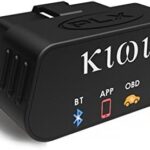Navigating the world of automotive diagnostics can be complex, especially when it comes to understanding On-Board Diagnostics (OBD) standards. For owners and enthusiasts of the Ford Falcon AU series, a common question arises: Can I use a standard OBD2 scanner on my vehicle? This question stems from the fact that while the AU Falcon, particularly models from the late 1990s and early 2000s, features an OBD2 connector, its diagnostic protocol compatibility isn’t always straightforward. Let’s delve into the specifics to clarify the situation for anyone looking to diagnose their Ford Falcon AU.
The Ford Falcon AU series, manufactured in Australia, was equipped with a 16-pin Diagnostic Link Connector (DLC), the physical interface we recognize as OBD2. However, the presence of this connector doesn’t automatically guarantee full compliance with the OBD2 protocols we typically associate with vehicles from that era, especially those in North America. Early OBD2 implementations varied significantly between manufacturers, and Ford Australia’s approach in the AU Falcon is a case in point.
Discussions in online forums, like the EFILive forum thread we’re referencing, highlight the confusion and practical experiences of users attempting to connect standard OBD2 scanners to their AU Falcons. One user, “odonus,” explicitly states that their OBD2 scan tool failed to connect, leading them to suspect that the AU Falcon might be using an OBD1-style EEC-V system despite having an OBD2 connector. This observation aligns with the understanding that Ford, in some of its international markets, implemented OBD systems that, while using the physical OBD2 connector, didn’t adhere strictly to the standardized OBD2 protocols like SAE J1979 or ISO 15031.
Further complicating matters is the mention of the “Siemens K Line protocol.” This suggests that instead of the standard OBD2 protocols like PWM, VPW, or CAN, the Ford AU Falcon might be utilizing a communication protocol more akin to earlier European or Asian standards. The K-line is a single-wire communication bus commonly used in automotive diagnostics, but it’s not part of the standard OBD2 suite of protocols mandated in many regions, particularly for emissions-related diagnostics.
So, what does this mean for Ford Falcon AU owners looking to use an OBD2 scanner? It indicates that a generic, entry-level OBD2 scanner might not successfully communicate with the vehicle’s Engine Control Unit (ECU). While these scanners are designed to read standardized diagnostic trouble codes (DTCs) and live data parameters over OBD2 protocols, they might not be equipped to handle the specific protocol implemented in the AU Falcon, such as the Siemens K-Line or a Ford-specific variant of EEC-V diagnostics.
The forum discussion also brings up the NGS (New Generation Star) tester, a diagnostic tool used by Ford dealerships in Australia. The fact that the NGS tester is mentioned as being effective with EEC-IV and EEC-V systems, and seemingly compatible with the AU Falcon, suggests that a Ford-specific scan tool or a more advanced, professional-grade scan tool capable of handling multiple protocols might be necessary. These advanced tools often include manufacturer-specific diagnostic capabilities beyond the basic OBD2 functions.
For Ford AU Falcon owners seeking a reliable diagnostic solution, here are some key takeaways and recommendations:
- Don’t assume OBD2 connector means full OBD2 compliance: The physical connector is present, but the underlying communication protocol may differ from standard OBD2.
- Generic OBD2 scanners may not work: Entry-level scanners relying solely on standard OBD2 protocols might fail to connect or retrieve data.
- Ford-specific scan tools are recommended: Tools designed for Ford vehicles, especially those with EEC-V systems, are more likely to be compatible.
- Consider professional-grade scanners: Advanced scan tools with multi-protocol support and manufacturer-specific diagnostics offer broader compatibility.
- Research specific scanner compatibility: Before purchasing a scanner, research its compatibility with Ford AU Falcon models or EEC-V systems, ideally looking for user reviews or manufacturer specifications confirming support.
In conclusion, while the Ford Falcon AU features an OBD2 connector, diagnosing it effectively may require moving beyond basic OBD2 scanners. Understanding the potential use of protocols like Siemens K-Line and the capabilities of Ford-specific tools is crucial for successfully reading diagnostic information and maintaining these iconic Australian vehicles. For accurate and reliable diagnostics, investing in a compatible scan tool or seeking professional diagnostic services familiar with Ford AU models is advisable.
